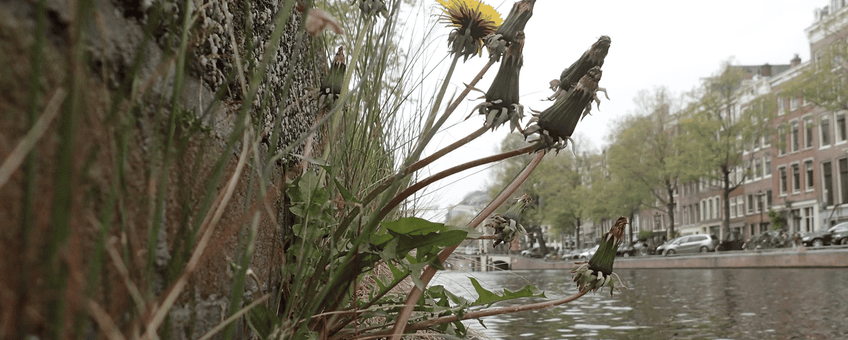
Dandelion evolves along with hot city
Netherlands Institute of Ecology (NIOO-KNAW)Is it possible for plants to get used to living in cities? Cities differ enormously from surrounding areas. One of the biggest and most consistent differences is temperature. City centres are often several degrees warmer than the countryside, this is known as the ‘urban heat island’. Buildings and roads trap a lot of heat, and a lack of greenery and water amplifies this temperature difference. How do plants cope with these higher temperatures? Little was known about this before. This new research, in collaboration with Naturalis and published in the December edition of Evolution Letters, shows that dandelions from cities are better able to cope with the heat than their counterparts from the countryside.

The study compared dandelions from areas from more to less urbanised. The research team drew a line from the centre of Amsterdam through the suburbs to the countryside, and along this they collected dandelion seeds. "It is a gradient of urbanisation," explains researcher Yannick Woudstra. Along this line, Woudstra and colleagues paid attention to the type of environment of the plant. Is it a street, roadside, urban park or a grassland where farm animals are kept? The comparison thus went beyond urban and rural plants.
Larger in urban heat
To prove that urban dandelions are more adaptable to heat, two tests were conducted on how these plants respond to heat. With warm summer temperatures, urban dandelions grow larger than those from outside the city. At 20 degrees Celsius, the differences were undetectable, but at temperatures of 26 and 32 degrees, the urban dandelions really fared better. Woudstra: "The urban plants make much better use of the heat. There is a caveat to that, of course. A bit higher is fine, but we also did an experiment at 38 degrees and then you see that that is just too much. They don't like a heat wave."

Flowering after winter
The second experiment showed that urban plants were more likely to flower after a mild winter. Many plants decide it is time to flower when they have been through a long cold period and it should therefore be spring. In mild winters, it is sometimes not cold enough, or the cold period is not long enough, to send that signal that flowering time is coming.
To recreate these circumstances, Amsterdam plants were exposed to a long, short or even no cold period in experiments at NIOO in Wageningen. Such a short cold period was not enough for most rural plants. There, most plants only flowered after a long cold period. Woudstra: "But many of the urban plants did flower, a clear difference was noticeable there." In the complete absence of low temperatures, none of the plants did well; very few flowers emerged then and there was no way to distinguish which group did better. So even urban plants still need a little winter.

Is it hereditary?
To conduct the experiments, dandelion seeds from different parts of Amsterdam were first grown for a generation in the NIOO greenhouse. This experimental set-up is known as a 'common garden experiment'. Lead researcher Koen Verhoeven: "If you measure plants in the field and they differ from each other, you don't know whether this is due to genetic differences or because of the environment. In a common garden experiment, at least you know for sure that they were all raised in exactly the same conditions. So if you do see differences, they must be hereditary."
How well does nature adapt to an environment changed by humans? "One of the biggest questions for ecology and evolution is how the plant and animal world deals with how we humans are rapidly changing the environment. Cities are an extreme example of this kind of change." Dandelion research helps answer that big question. According to Verhoeven, the value of this research lies in showing that plants can certainly adapt to urban heat up to a certain level.

Analogy for climate change
"I look at cities as little islands of climate change. You can already see that two-degree difference between Amsterdam and the countryside around it. So we are talking about a temperature scale that is very relevant" Verhoeven argues. Does this adaptation of dandelions to warm cities mean that plants are resistant to climate change? According to Verhoeven, it is not that simple to say, and other adaptations are also needed. Besides this rapid adaptation – where dandelions can make use of their existing diversity and the ‘suitable’ ones always survive – long-term changes also require new variations: "These are new 'mutations' in the DNA. Those are also continuously occurring, and they are needed to keep adaptation possible in the long term. But can they keep up with the changes? That is the real question."
More information
- With more than 200 staff members and students, the Netherlands Institute of Ecology (NIOO-KNAW) is one of the largest research institutes of the Royal Netherlands Academy of Arts and Sciences (KNAW). The institute specialises in water and land ecology with three major themes: biodiversity, climate change and the sustainable use of land and water. Since 2011 NIOO is located in an innovative and sustainable research building in Wageningen, the Netherlands. NIOO has an impressive research history that stretches back 70 years and spans the entire country, and beyond.
- Lead researcher Koen Verhoeven, Department of Terrestrial Ecology, Netherlands Institute of Ecology (NIOO-KNAW), 0317-473599, k.verhoeven@nioo.knaw.nl
- Researcher Yannick Woudstra, previously Netherlands Institute of Ecology (NIOO-KNAW) and Naturalis, yannickwoudstra@outlook.com
- Science information officer Froukje Rienks, Netherlands Institute of Ecology (NIOO-KNAW), tel. 0317-473590 / 06-10487481, f.rienks@nioo.knaw.nl
Text: Jiska Vaarwerk, Netherlands Institute of Ecology (NIOO-KNAW)
Photo's: Yannick Woudstra, previously Netherlands Institute of Ecology (NIOO-KNAW)
Map: Atlas Leefomgeving
